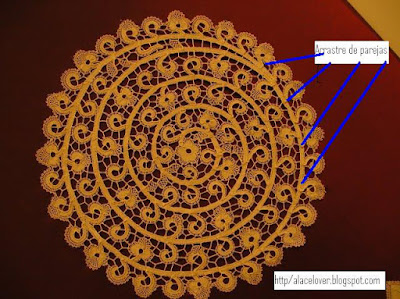 |
| "Encaje Rococó". Las cintas y las florres tienen pies. Se quita y se ponen bolillos según se necesite |
A continuación os doy unas instrucciones que creo os ayudarán a diferenciarlos.
Los diseños son muy parecidos en los dos, pero se trabajan de forma diferente.
Una vez que se aprende la diferencia, es muy fácil distinguirlos.
Los diseños de los dos tienen ramitas enroscadas, hojas curvadas y flores estilizadas de 3 o 5 pétalos.
El Encaje de Cantú se hace con el mismo número de bolillos desde el inicio hasta el final, es decir ni se quitan ni se añaden nuevos bolillos. Cuando alguna pareja no se necesita se agrupan en un manojo en un lateral y se van arrastrando. Cuando se necesitan, se integran de nuevo a la labor. Las ramitas no llevan pies. Se trabajan sin alfileres. Mientras se trabaja, simplemente se le clava de vez en cuando un alfiler, para mantenerlas en su sitio.
En el Encaje Rococó, estas ramitas se trabajan como una cinta con dos pies.
Una vez que se aprende la diferencia, es muy fácil distinguirlos.
Los diseños de los dos tienen ramitas enroscadas, hojas curvadas y flores estilizadas de 3 o 5 pétalos.
El Encaje de Cantú se hace con el mismo número de bolillos desde el inicio hasta el final, es decir ni se quitan ni se añaden nuevos bolillos. Cuando alguna pareja no se necesita se agrupan en un manojo en un lateral y se van arrastrando. Cuando se necesitan, se integran de nuevo a la labor. Las ramitas no llevan pies. Se trabajan sin alfileres. Mientras se trabaja, simplemente se le clava de vez en cuando un alfiler, para mantenerlas en su sitio.
En el Encaje Rococó, estas ramitas se trabajan como una cinta con dos pies.
Resumiendo, en el estilo Rococó se quitan y se ponen bolillos, según la necesidad y en el estilo Cantú se mantiene el mismo número de bolillos a la largo de todo el proceso de ejecución. Si tienes una pieza de este estilo y quieres saber de cual es con exactitud, mira en el borde de las cintas y de las hojas. Si hay un atado de hebras en el borde, entonces es Cantú. Si las ramitas y las hojas tienen pies, se trata de Rococó. El encaje de Cantú se trabaja muy cerrado, mientras el Rococó es más abierto y a menudo se hace con hilo mas fino.
Ambos estilos son muy fáciles y bonitos de trabajar. Los diseños se pueden trabajar en cualquier de los dos estilos.
------------
There are two types of laces that resembles each other very closely, namely: CANTU from Italy ROCOCO from Belgium
The designs of the two laces are very similar, but they are worked quitedifferently; once this difference is understood, the two laces are easy to distinguish.
Both have a design that has curling branches, simple curled leaves, very stylized flowers with 3 or 5 petals, and a distinctive "bud".
In Cantu, the lace is worked with a consistent number of pairs, some of which are held in a bundle and wrapped around one side of the tape with the worker pair when not in use. The tape "stem" is worked without pins, having a turning stitch on one side, and the bundle on the other.
As you work the stem you simply stab it in the middle with a pin to hold it in place until you get to a point where you need pins.
In Rococo, the stems are worked as a tape with two Footside edges.
In short, in Rococo you are adding and removing pairs all the time., In Cantu you keep them all in, bundling those you don't need. If you have a piece of this type of lace, and want to know what it is, look at the edges of the tapes and leaves: if there is a bulge of threads on one side, it's Cantu. If the stems and leaves have Footside edges, it's Rococo. Cantu is worked very densely; Rococo less so, and often with finer thread.
Both of these laces are very fun to work, and easy to design. The patterns can be worked in either style.
 |
| "Encaje de Cantú" Fijaos en cómo se ven las zonas en las que se arrastran las parejas que no se han trabajado |
No hay comentarios:
Publicar un comentario